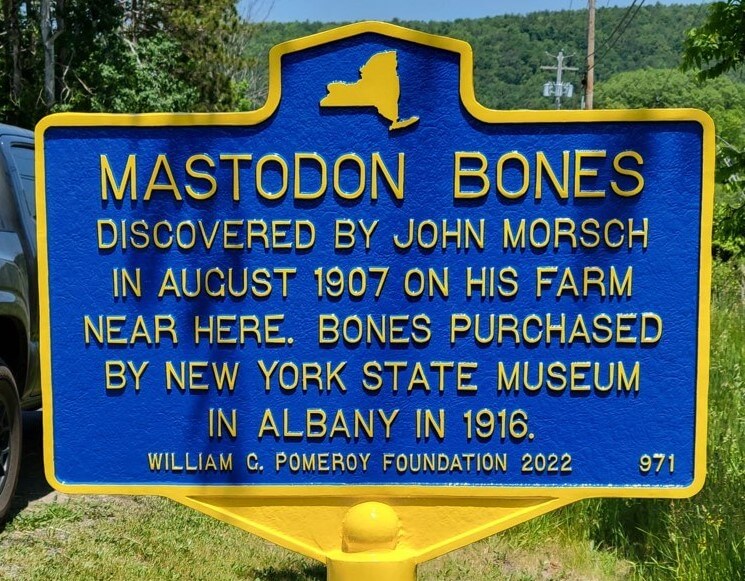MASTODON BONES
- Program
- Subject
- Location
- Lat/Long
- Grant Recipient
-
NYS Historic
-
Education, People, Science
- 11181 Chapel St, Wayland, NY 14572, USA
- 42.54401, -77.62723
-
Town of Wayland Historian
MASTODON BONES
Inscription
MASTODON BONESDISCOVERED BY JOHN MORSCH
IN AUGUST 1907 ON HIS FARM
NEAR HERE. BONES PURCHASED
BY NEW YORK STATE MUSEUM
IN ALBANY IN 1916.
WILLIAM G. POMEROY FOUNDATION 2022
In August 1907, John Morsch discovered a number of large, well-preserved bones buried on his farm in Perkinsville in Steuben County, New York. Morsch had been digging around some rocks when he came across the bones, having first unearthed what appeared to be a large leg bone. The bones were eventually identified as having belonged to a mastodon. The New York State Paleontologist included Morsch’s discovery in their 1907 annual report, providing a summary description of what Morsch had found:
“These bones lay largely in their natural position and while perhaps the numerical two thirds of the skeleton were preserved, the more conspicuous bones were fragmentary or wanting. At the conclusion of the excavation it was found that all four legs and feet, a large number of ribs and vertebrae, parts of the shoulder girdle and one ramus of the lower jaw with teeth had been recovered.”
Local newspapers also reported on Morsch’s discovery, including the September 27, 1907 edition of the Steuben Courier:
“Several of the animal’s teeth were found, including one tooth which weighs 9 ¼ pounds. All of the bones were fairly well preserved. The place where the skeleton was found is marsh, and the bones lay at a depth of only about four feet beneath the surface.”
The Steuben Courier concluded that about 200 bones had been found, noting the great interest and excitement the discovery had generated throughout the surrounding area.
The local papers reported that a number of universities and institutions were interested in the bones. The October 2, 1907 Cohocton Valley Times and Index noted that professors from Cornell and also the University of Rochester had travelled to the Morsch farm to examine the skeleton shortly after its discovery.
In 1916, the New York State Museum in Albany acquired the mastodon bones found in Perkinsville for the museum’s paleontology collection, having purchased the bones from Ward’s Natural Science Establishment of Rochester. Some portions of the skeleton were loaned to the Tackapausha Museum and Preserve in Nassau County, and as of 2022, the remaining Perkinsville mastodon bones are still in the collection of the New York State Museum.

